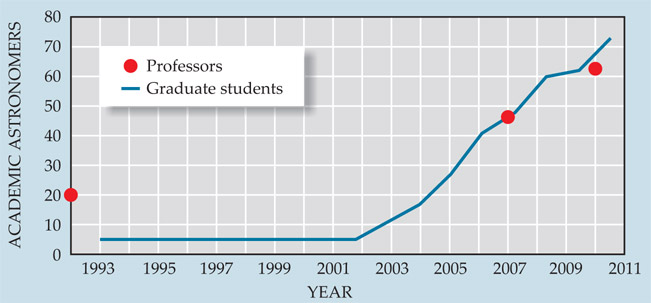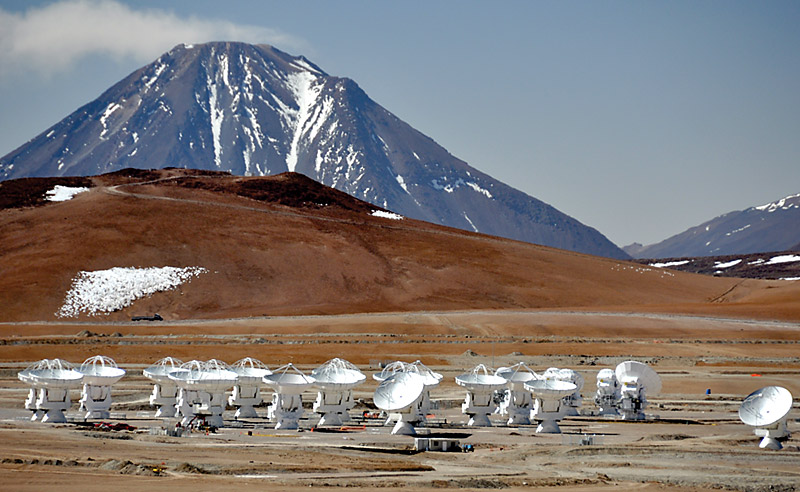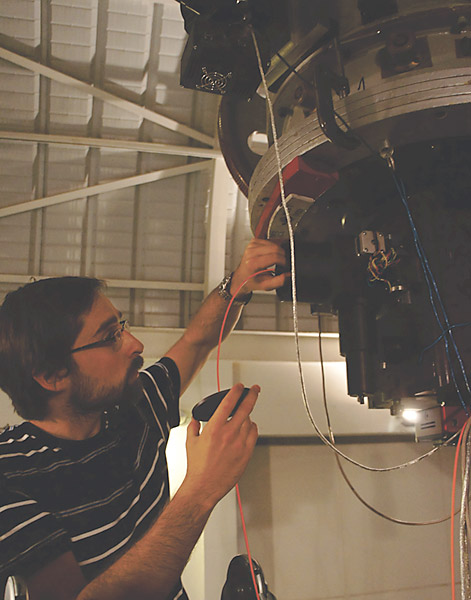Chile aims to better exploit role as telescope host
DOI: 10.1063/PT.3.1394
Wine, copper, and mountains, move over! Add astronomy to the things that Chile is known for and that make up its cultural identity. The country has been home to international telescopes for nearly 50 years. Now the Chilean government is stepping up its efforts to reap economic, educational, and cultural benefits from the observatories’ presence.
Some of the world’s best sites for astronomy are in Chile, thanks to high altitudes and clear, dry skies. In September, the international Atacama Large Millimeter/Submillimeter Array (ALMA) opened to experiments, joining dozens of telescopes that have made Chile their home since the early 1960s. Future projects coming to the country include the European Extremely Large Telescope, the Tokyo Atacama Observatory, the Cornell Caltech Atacama Telescope, the Giant Magellan Telescope, and the LSST (Large Synoptic Survey Telescope). By 2020 Chile will have an estimated 70% of the total surface area of the world’s telescopes, notes Mónica Rubio, director of astronomy for Chile’s National Committee for Science and Technology (CONICYT). “The main discoveries in astronomy in the next decade will come from Chile.”
About three years ago CONICYT declared astronomy a “strategic area.” That means, says Rubio, “there will be major efforts by the agency to attract more funding from the government.” A national decree issued more than a decade ago protects three northern regions of the country from light pollution; now the government is establishing an “astronomy park” for future observatories, where mining and geothermal and water exploitation are prohibited. And to leverage the telescopes to have the biggest possible impact on Chile, CONICYT and four other government agencies are creating a roadmap, due out early this year, to “define the capacities and needs of the country—universities and industry—to participate in joint ventures and in the development of the new [astronomy] facilities,” Rubio says.
“This is the first time that the government sees that investing in pure science will have an impact on the economy and industry,” says Michel Cure, an astronomer at Chile’s University of Valparaíso.
Technology opportunities
Development of astronomy in Chile has come in three waves, says Angel Otárola, a Chilean atmospheric scientist at the University of Arizona and a member of a working group that is making recommendations for the roadmap. In the first, decades-long wave, Chilean astronomers went abroad for their PhDs, and the University of Chile in the capital city of Santiago was the only place for astronomy research. The second wave began in the late 1990s, with 8-meter-class telescopes and an expansion of astronomy to other universities. “Now we are in the third wave,” says Otárola. “Chile would like to be part of developing the technology related to the observatories.”
So far, third-wave activities are mainly confined to university-based instrument-building programs. The most established instrumentation program is in radio astronomy at the University of Chile, where a prototype receiver for ALMA is nearly complete. The receiver is for 31–45 GHz, a frequency band into which ALMA may expand. If adopted by ALMA, the receiver could lead to local spin-off companies to help build replicas to outfit the array’s many antennas.
At the three-year-old Center for Astro-Engineering at the Pontifical Catholic University (PUC) in Santiago, scientists and engineers build telescope instruments and have a computing lab that specializes in data management in anticipation of the data barrage the LSST will produce. The center’s Dani Guzmán is beginning conceptual studies for a multi-object spectrograph that he plans to propose for the European Southern Observatory’s (ESO’s) Very Large Telescope. He is also involved in designing cameras for the Giant Magellan Telescope.
Astronomy-technology activities are also under way at the Federico Santa María University in Valparaíso and at the University of Concepción, which in 1995 became the first university outside the capital to start an astronomy program. At Concepción, the focus is on the design and construction of instruments to monitor atmospheric turbulence and humidity.
Not only do Chilean astronomers want to get involved in the observatories at the design stage, but “the government sees opportunities to do things with what astronomy develops,” says Leopoldo Infante, director of the astro-engineering center. The roadmap, says Otárola, is “essential for the government to implement public policy and funding” to support the development of technologies and know-how that will spill over into other areas, such as renewable energy, defense, communications, and agriculture. “The whole idea is to provide the young generations of engineers and scientists opportunity to become actors in the development of technology,” he says.
Opening doors
In the past decade, the numbers of students entering astronomy programs in Chile has skyrocketed (see graph on page 3). The growth is tied to an overall expansion in universities and university attendance, says PUC astronomy professor Alejandro Clocchiatti. But for astronomy, “it’s like we are surfing a wave. We don’t have to make the wave—it’s made by the US, Europe, China, and Japan. We don’t need to have world-class might to do world-class astronomy. Many institutions see this as an opportunity.” When PUC started an undergraduate program in astronomy, he says, the physics program “passed from gathering mediocre students to very good students.” Clocchiatti says astronomy “allowed kids finishing high school to stand up to social pressures against being a scientist.

Astronomy is growing fast in Chilean universities, due in large part to money from observatories and to efforts by the Chilean government to take advantage of their presence.
Data supplied by CONICYT

Ironically, many won’t end up in astronomy. Astronomy opened the door to many sciences.”
By any metric, the astronomy community in Chile is booming. Since the mid 1990s, the number of universities with undergraduate astronomy programs is up from one to seven, and it continues to grow. The number of universities offering PhDs in the discipline has grown from zero to three; the first, at the University of Chile, was started in 1999. And the number of astronomy researchers has tripled, as of August 2011, to 62 professors and 48 postdocs. In each of the past five years, more than 200 papers with Chilean coauthors have been published. “At the older observatories, even the toilets are American. They brought everything,” says Guzmán. “Now, in terms of personnel, maybe 70–80% are Chilean. We are also participating in, but not leading, more advanced instruments. It will be a long process.”
“Chilean astronomy has expanded into a vigorous community” thanks to the 10% of telescope time—totaling 1000 nights a year—that international observatories reserve for Chilean institutions, says Mario Hamuy, an astronomer at the University of Chile and president of the council of the main grant program within CONICYT. Demand for observing time outpaces availability by about two and a half times; for other countries the rate is often twice that. Access to the telescopes has made Chile an attractive place for postdocs and faculty from abroad; they make up more than half of Chile’s astronomy faculty and around 90% of its postdocs. And astronomers at Chilean institutions have the possibility to plan projects that require multiple telescopes; astronomers from other countries have to contend with the various partner countries involved in each observatory. But more internal competition among Chilean institutions would be better, says Hamuy.
And as more telescopes turn on, keeping “a healthy pressure” among Chilean institutions will require doubling the astronomer population, says Hamuy. That, he estimates, will cost an additional $10 million a year, a “relatively small” amount compared with the total of more than $900 million the government spends annually on R&D. Astronomy gets only about 1% of that, including money from CONICYT, the ministry of economy, and $1.4 million from the observatories. Another $10 million a year is also a small investment, Hamuy notes, to take advantage of some $3 billion that other countries have ponied up for the observatories.
A turning point
The observatories’ annual monetary contributions to the development of astronomy in their host country stem from what proved to be a turning point for Chile. The Chilean government had promised land to ESO for the Very Large Telescope. But the land was privately held, and it took a trial and much publicity before the government and ESO in 1996 reached an agreement: Like the other international observatories, ESO would allot 10% of telescope time for Chilean astronomers. And instead of paying for the land, ESO would provide about $500 000 a year for astronomy in Chile. ALMA and the Gemini Observatory contribute similar amounts. In its successful bid to attract the European Extremely Large Telescope, Chile weakened the conditions to 2.5% purely for Chile and 7.5% for collaborations between members of Chilean and ESO member country institutions. The world’s other top astronomy sites, in Hawaii and Spain, often get more than 10% of the time on telescopes they host.
The publicity around the trial led to awareness about astronomy among the Chilean public. It had been a “curiosity,” says Hamuy. “Now astronomy is in the newspapers and on TV several times per week. Astronomy is becoming very popular among children. It is a cause of pride and is becoming part of national identity.”
Still, the impact on the economy has so far been small. In northern Chile, where most of the telescopes are, the impact has been “nonnegligible,” says Hamuy, although mining and tourism both put more money into the local economy. The impact of astronomy on industry and technology is just beginning, says Clocchiatti. “I hope and wish that new initiatives will fly. But I don’t dare to put a time scale” on when change will be evident.

The Atacama Large Millimeter/Submillimeter Array in northern Chile is more than one-third complete. When finished in 2013, it will consist of 66 radio telescopes spread over nearly 260 square kilometers at an altitude of about 5000 meters.
J. Stoke (NRAO/AUI/NSF)


A fiber spectrograph made at the Center for Astro-Engineering at the Pontifical Catholic University in Santiago, Chile. The instrument, here attached to a 50-cm telescope, is viewed as a stepping stone toward building more advanced spectrographs.
Leonardo Vanzi

More about the Authors
Toni Feder. tfeder@aip.org
